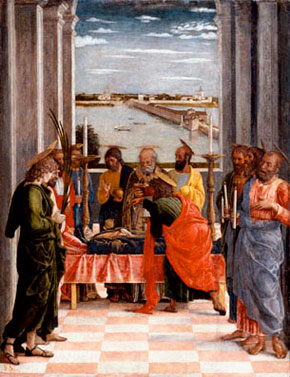Auditorium
Presentation of the Exhibition:
Wednesday September 24 at 12:30 noon.
By Giovanni Agosti, University of Milan, and Dominique Thiébaut, Musée du Louvre, with the participation of Richard Peduzzi, architect and designer
Cycle of lectures at 6:30 p.m.: Andrea Mantegna, “Primo pictore del mondo”
This lecture cycle will enable the visitor to place this major painter of the Italian Renaissance in a wider perspective. The study of Mantegna's art and personality will be the starting point of a reconsideration of the values of Humanism and the important issues of reference to Antiquity, that modern vision and reinterpretations have sometimes diverted from their original meanings.
Monday, September 29
Mantegna: The Invention of a Humanist Painter
By Keith Christiansen, The Metropolitan Museum of Art, New York
In English
Monday, October 6
Andrea Mantegna and the Frescoes of the Ovetari Chapel in the Church of the Eremitani in Padua
By Alberta De Nicolò Salmazo, University of Padua
In Italian
Monday, October 13
Mantegna, Mantua and the Image of the Roman Empire
By Stephen J. Campbell, Johns Hopkins University, Baltimore
In English
Monday, October 20
Itineraries of Mantegna's Modern Reputation
By Alessandro del Puppo, University of Udine
In French
Monday, October 27
The Ancients and the Moderns in Mantegna's Art
By Jacques Darriulat, University Paris IV-Sorbonne
In French
Films on Art/Artist's Film
Monday, October 13, at 12:30 noon
Au commencement l’eau et le lait
By Sarkis, Fr. 2001, 10 min, color
After Mantegna's Crucifixion (Louvre).
The artist Sarkis was inspired by Mantegna's San Zeno altarpiece to realize three films. The last one, Au commencement l'eau et le lait (In the Beginning, Water and Milk), is based on the Crucifixion, which Sarkis "stratifies" evoking the instant preceding its creation. By this act of reminiscence he attempts to "re-iconify" the original work.
Mantegna: The Triumphs of Caesar
by Dudley Shaw Ashton, G.-B., 1973, 24 min, color, original version, French subtitles
The Triumphs of Caesar painted between 1486 and 1506, were considered as Mantegna's most important work. Cleaned and restored, the canvases show a Triumph of Roman Antiquity in a Renaissance style of fantasy. The commentary was written and recorded by Anthony Blunt (1907-1983), eminent British art historian.
The Camera Picta (La Camera degli Sposi)
by Anna Zanoli, Italy, 1988, 30 min, color, original version, simultaneous translation into French.
Series: Masterpieces being restored.
Reading
Monday, December 15, at 8:30 p.m.
Andrea Mantegna: Vies des plus excellents peintres, sculpteurs et architectes by Giorgio Vasari (French translation).

